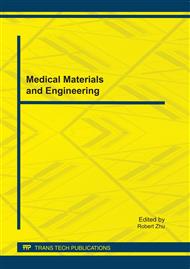p.128
p.132
p.137
p.142
p.152
p.157
p.162
p.167
p.172
Improved Identification of White Blood Cells and Renal Tubular Epithelial Cells in Urine Using Cytology
Abstract:
Objectives: Conventional automatic identification system to differentiate white blood cells from renal tubular epithelial cells was limited by overlapping parameters and investigation of clear classification of these two cells could be critical to diagnosis and prognosis. Methods: Urine samples from 120 individuals (30 bladder cystitis, 30 glomerular nephritis, 30 pyelonephritis and 30 nephrotic syndrome) were collected. Urine sediments were stained by Sternheimer method and examined by TJYDSXG-1 microscopic cell analysis system including cell size, degree of cytoplasmic staining and nuclear coefficient of variation (CV). Peroxidase chemical staining was also employed to differentiate white blood cells (WBC) and renal tubular epithelial cells (RTEC) in sediments. Results: WBC in urine sediment was (8-13) μm, while (10-16) μm for RTEC, with 36% overlapping of nuclear CV. Peroxidase chemical staining intensity index is 0-4 for WBC and 0-1 for RTEC. Conclusions: Percentage of overlap between WBC and RTEC can be reduced to 7%-13% when Sternheimer staining was combined with peroxidase staining.
Info:
Periodical:
Pages:
152-156
Citation:
Online since:
November 2011
Authors:
Price:
Сopyright:
© 2012 Trans Tech Publications Ltd. All Rights Reserved
Share:
Citation:


